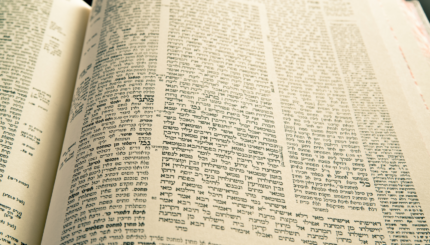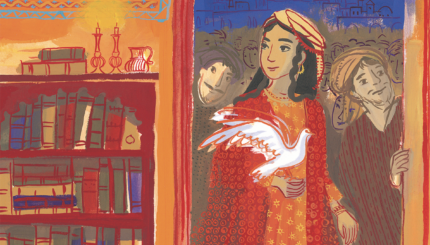Over the past few decades, a new and distinctive movement has emerged among Jews who are attempting to reclaim some kind of spiritual meaning for their lives. The question has been: If we are recovering our connection to the Divine, can we find that connection in traditional Judaism?
Confronting Divine Imagery
The question has been particularly difficult for many Jewish women because of the picture of G-d we inherited. The G-d we learned about as youngsters, that distant, kingly figure who watched over us seemed, for women discovering their feminine consciousness, too blatantly male. In popular feminism, the G-d of the Hebrew Bible, of Jewish, Christian, and Muslim tradition, has gotten a bad reputation as the patriarchal G-d of Western culture. Some turned to other religions in search of a G-d beyond gender or a philosophy that did not require a belief in G-d at all.
Is it true that G-d in Jewish teachings is patriarchal, that is, thoroughly imbued with male characteristics and values?
On first glance, it would seem so. After all, G-d appears to be male. The siddur (prayer book) and the Bible refer to G-d only as He. Traditional Jewish teachings point out that G-d is really beyond all attributes, including those of gender. But, feminist writers have argued, while that is a nice theory, we as human beings need to use symbols and words to express our experience of the Divine.
With your help, My Jewish Learning can provide endless opportunities for learning, connection and discovery.
Can We Not Call G-d She?
Actually, there is nothing wrong with an individual’s using feminine words for G-d to address her as mother or imagine oneself talking to an intimate female friend. For some individuals, this helps to develop a richer and more intimate relationship to G-d. We can also write and share our own interpretations of G-d’s compassion, G-d’s judgment, G-d’s creative work in the world in feminine terms. This may help us to come to experience the fullness of G-d in our lives.
Changes in the Realm of Public Prayer
But this is not a full answer, for there is still the arena of public prayer, [for] which tradition insists that we should adhere to the established text of the siddur. Here many feminists are eager for changes in language and substance. Some Jewish organizations have rushed ahead to revise translations of the prayer book, eliminating gender references, sometimes eliminating portions of the prayers themselves.
We must say, first of all, that this does injustice to the Hebrew language itself, not to mention the centuries of prayer of the Jewish people, who cherished these words as the channels by which we might address G-d. The issue is not merely introducing some feminine language for our personal enrichment, but our relation to the whole of Jewish tradition and the whole Jewish people.
Nor is it only a matter of dutifully respecting the communal tradition. We are easily led astray here because of our cultural disposition to value individual self-expression. We tend to honor the tradition only so long as it feels authentic to us. But what this really means is that we do not well understand communal expression, so we tend to brush it aside.
We must ask: are there not some powerful reasons why our sages have, through the centuries, kept a certain kind of language for our address to G-d, and have been very careful about what comes to be included in our siddur?
Indeed there are.
The Sexual Relationship between God and the Jews
The mystics tell us, following images used by the prophets, that our relation to G-d, as a people, can be conceived in sexual terms. G-d is male, the Jewish people is female. The Shir HaShirim, Song of Songs, which accompanies the celebration of Pesach [Passover] and which, in some communities, is sung every Friday night, represents G-d and Israel as two lovers.
The holidays can be mystically conceived as representing seasons in the relationship between Israel and G-d: Pesach is the first commitment of the two lovers the engagement, so to speak; [the holiday of] Shavuot is G-d’s giving us his ketubah or wedding contract; and [the holiday of] Sukkot is the consummation of the marriage. In a related set of images, all souls of Israel together is the Shabbat Queen, who is also the Shekhinah (feminine aspect of the Divine), who unites with her husband, G-d, on Shabbat.
These images are a way to convey to us that the relation between G-d and human beings is a dynamic model, of which our best understanding is the relation between male and female. If our imagination fails at this point, it is partly a failure of our society, particularly of the widespread weakening of marriage and family in our times. Our grasp of the true meaning of the marriage relationship is dim and vague. We tend either to idealize it as romance (the teenagers Romeo and Juliet), or we criticize it as an instrument of patriarchal oppression, where the husband owns and dominates the wife.
Thus, some feminist writers have severely criticized the Jewish image of the Divine/human marriage. For example, Rosemary Ruether attacks the images found in some of the prophetic writings which accuse Israel of being the harlot while G-d acts like a petty, jealous husband.
This criticism totally fails to understand the depth and richness of the husband/wife experience in Judaism and, in particular, the, notion of fidelity as part of marriage. Most of us today can barely grasp this, so we miss how the symbol of G-d as the husband and the Jewish people as the wife is the deepest imaginable relationship. Yet this image, this metaphor for G-d and the Jewish people, holds the secret of the apparently patriarchal language of [the] Bible and siddur, the masculine terms we use for G-d.
Feminine Power
In our days of new feminine consciousness, when we are asking what it means to be female or male, this language turns us back to our fundamental relationship to G-d. A woman discovering herself as woman first questions G-d: Why do you appear as male? Or she questions the rabbis: Why did you write about Him as like you and not like us? But we must push the question to a deeper level: what do masculine and feminine, male and female, really mean? How are they unique and how do they come together?
We must certainly reject the interpretation that the male (G-d) has all the power and the female (Israel) is his instrument. That would be thoroughly un-Jewish. We need only recall the famous Talmudic story of Rabbi Eliezer, who was intent on having G-d put his personal seal on a certain halakhic [Jewish legal] decision. The sages, however, decided the matter another way. G-d’s response was, Thus my children have decided. G-d might well have said, in the above anecdote, Thus my wife has decided. For, in another context, G-d tells Abraham, In all that Sarah tells you, listen to her voice.
The feminine has power, influence, and impact on the world just as does the masculine. They are in continuous interaction, an ongoing dance, in which each elevates and enriches the other.
Retaining God’s Male Face
This metaphor of G-d and Israel as husband and wife helps us understand that when we address G-d as a community, we address Him as male. When we pray in the traditional ways, we are not merely doing our duty by honoring what has been passed down. We are entering into a relationship with G-d by our speech, helping to create a relationship that has its own dynamic, the dynamic of the people Israel speaking, in love and intimacy, to her Divine partner. And, as with a marriage, it is only with years of practice that the full richness of this communication becomes a reality for us.
The so-called patriarchal G-d thus turns out to be only one face of G-d. The question once was asked why, in our prayers, we address G-d as G-d of Abraham, G-d of Isaac, and G-d of Jacob rather than more simply as G-d of Abraham, Isaac, and Jacob. The sages answered: Because G-d showed a different face to each one.
So also with us.
We live in a time when many are speaking of the feminine faces of G-d; this brings to our awareness dimensions of G-d that we might have forgotten. We may also see Him in more traditional terms as Creator, Ruler, Redeemer, Giver of the Torah. We need not reject any of these, male or female, but only use them to deepen our understanding of ourselves as individuals, of our people, and of G-d. Learning to live with and think deeply into our words for G-d is part of our spiritual growth, part of the deepening of consciousness we see in our times.
Excerpted and reprinted with permission from Feeding Among the Lilies, edited by Baila Olidort and published by Kehot Publication Society.
ketubah
Pronounced: kuh-TOO-buh, Origin: Hebrew, the Jewish wedding contract.
Pesach
Pronounced: PAY-sakh, also PEH-sakh. Origin: Hebrew, the holiday of Passover.
Shabbat
Pronounced: shuh-BAHT or shah-BAHT, Origin: Hebrew, the Sabbath, from sundown Friday to sundown Saturday.
Shavuot
Pronounced: shah-voo-OTE (oo as in boot), also shah-VOO-us, Origin: Hebrew, the holiday celebrating the giving of the Torah at Mount Sinai, falls in the Hebrew month Sivan, which usually coincides with May or June.
siddur
Pronounced: SIDD-ur or seeDORE, Origin: Hebrew, prayerbook.
Sukkot
Pronounced: sue-KOTE, or SOOH-kuss (oo as in book), Origin: Hebrew, a harvest festival in which Jews eat inside temporary huts, falls in the Jewish month of Tishrei, which usually coincides with September or October.



